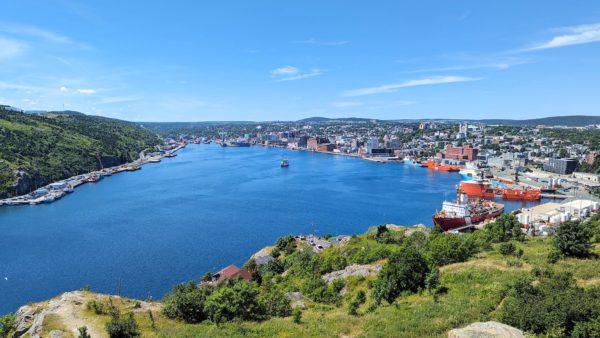
At the southeastern corner of the island of Newfoundland, St John’s is the largest city in Newfoundland and Labrador. At this moment, about 530,000 people live in NL, and 212,000 of them (40%) live in the St John’s metro area. [By contrast, just 26,650 (5%) live in all of Labrador, though Labrador accounts for 72% of the land area of the province.] Anyway, statistics aside, we were eagerly anticipating our visit to the urban St John’s for several things we would find there: music, history, hiking, sightseeing… and a Sprinter service center.

For better or for worse, the timing of our visit to this amazing city was driven by the service schedule at Mercedes-Benz St John’s. When we had our air conditioning repair near Bishop’s Falls, the mechanic found another problem with the engine, and for this we’d need to see a dealer. Fortunately there is one authorized service center for Sprinters in NL, and it is in St John’s. We were able to book an appointment two weeks out, which gave us the time to spend in Fogo and Twillingate before we made our way to the big city.
Eventually we arrived in St John’s to spend a few nights at the Pippy Park Campground – a remarkably rural-feeling campground that is right in the city – set up camp and started making plans for what to do around our service appointment. And this is where our earlier discussion of RV cohorts in the previous post comes into play. Our new friends Chris and Kim (not to be confused with our old friends Kim and Chris), owners of a Winnebago View with New Hampshire plates that we first noticed several times in various parking lots in and around Newfoundland, and who we met in person on the trail on one of our hikes, and again later on another of those hikes, and then in town… In these informal meet-ups we spent enough time chatting and sharing stories and comparing vehicles that we quickly became friends and, although it looked like our paths would probably diverge once we both left the Gros Morne area, we exchanged contact info, wished each other safe travels, and agreed to stay in touch.
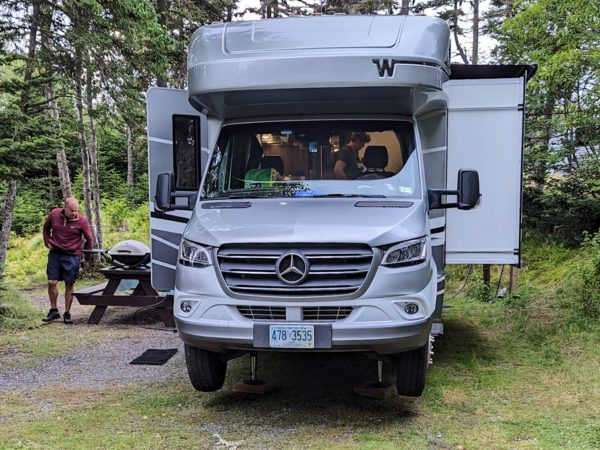
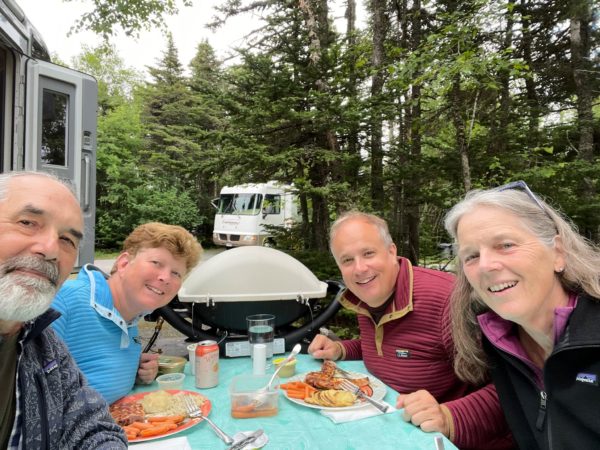
On our second evening at the campground in St John’s, the day before our impending service appointment, we got a message from our new friends that said, “Hey, we are literally in the campsite next door to you!” Chris and Kim had a reservation on the ferry to Nova Scotia and had planned to spend a couple of days in St John’s before leaving the island. So they arrived at their reserved site at Pippy Park and set up in their assigned spot, right next to a familiar-looking, older Winnebago View with Vermont plates. What?! So we brought our dinner over to their place and shared more stories around the picnic table. We also remembered to get a photo or two this time, and we made tentative plans to get together for dinner out and a music festival event the following evening, depending on how our truck repair went.
Early the next morning, Sue and I headed over to the Mercedes dealer where we enjoyed amazingly fast WiFi, comfortable chairs, and free coffee while waiting for news of our fate. Towards the end of the day, we learned that our truck could be repaired, parts were needed (and already ordered by overnight air freight), and we shouldn’t drive it until it was fixed, although we could stay in it in the lot behind the dealership until the parts arrived. Oh, and also, tomorrow is Royal St John’s Regatta Day, so if the weather is good for the racing, then all the businesses in St John’s will be closed and everybody takes the day off. So check with us in the morning – if the door is locked, then the Regatta is on and it will be another day before we can get to your repair. Really? Wow.
That seemed a little odd, but it’s how they roll here in St John’s. The Regatta is a time-honored local tradition that is uniquely St John’s, and honestly it worked out great for us. Read on…
Having spent Repair Day One sitting in our comfortable chairs and catching up on various things, we really needed to stretch our legs. It was about an hour’s walk from our new campground (Mercedes-Benz St John’s) to George Street, where there were restaurants, pubs – and music! Part of the annual celebration around the Regatta involves music and entertainment, and in fact this was the penultimate night of the annual George Street Festival. The street is closed, the pubs are open, and the stage is set! On this night, three of Newfoundland and Labrador’s most legendary bands were on the main stage to play Newfoundland traditional music, Celtic rock, and more.
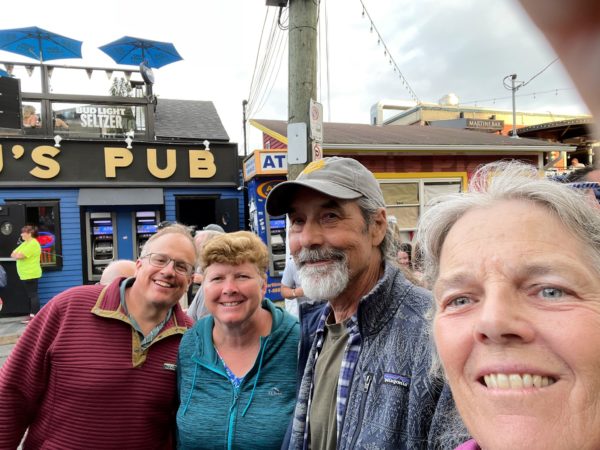
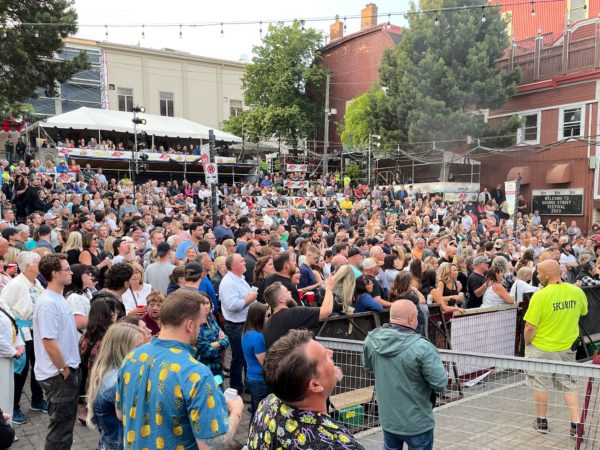
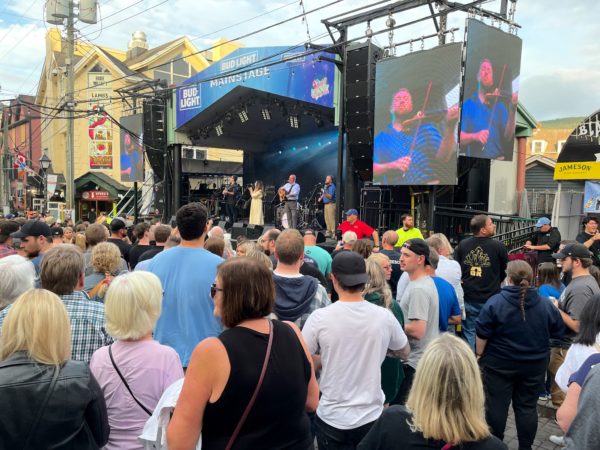
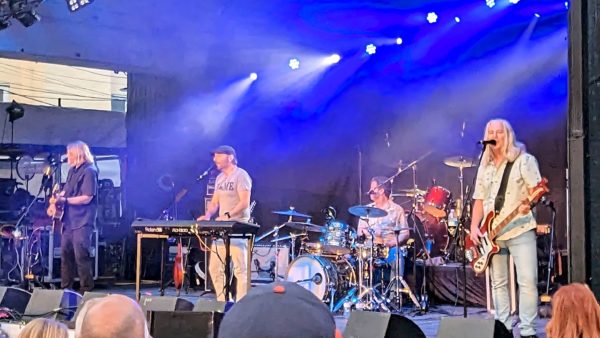
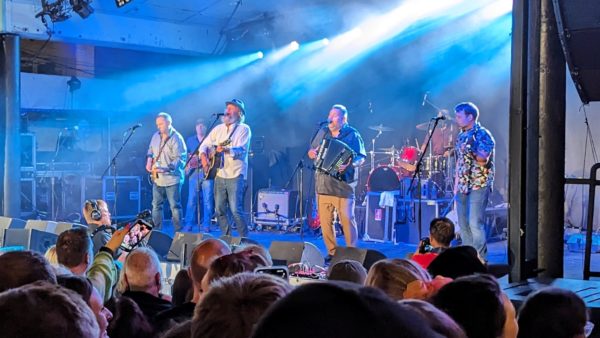
Chris and Kim met us at Jungle Jim’s restaurant for dinner, after which we made our way into the core festival area, eventually establishing a spot for ourselves up near the front with a good view of the stage. The first band was The Irish Descendants. This band is made up of former workers in the fishing industry, born of Irish emigrants, who play traditional and original tunes with a driving Celtic rock sound. We were impressed and a little surprised by how many of their songs we recognized (including the original ones), many of which we’d only heard for the first time earlier in our NL travels. Next up was Signal Hill, a rock powerhouse from St John’s (now based in Halifax, which is more accessible to more places for their gigs) who shared more rock-infused traditional Newfoundland music, interspersed with a few incredible covers of iconic songs from our past. Of particular note in that last category were their renditions of Bohemian Rhapsody and Paradise By The Dashboard Light. The headliner, Shanneyganock, has been playing sea songs and traditional folk ballads, shanties, jigs and reels with uniquely Newfoundland style for nearly 30 years. We were taken away by this performance. We couldn’t help but move with the music – a good thing, since it seemed to have the same effect on everyone around us. It appeared all in the audience (except us) knew all of the words to all of these songs. This was an amazing experience and a fantastic way to hear the sounds of Newfoundland.
The next morning (Repair Day Two) we awoke to clear skies and little wind, perfect weather for the Regatta, and, as promised, nobody home at the Mercedes shop. Probably we ought to see what this Regatta is all about, right? This was the day of Kim and Chris’ ferry departure, so we were again on our own. There are no Ubers in St John’s, but there is great taxi service and we easily got ourselves right to the center of activity for the Regatta.
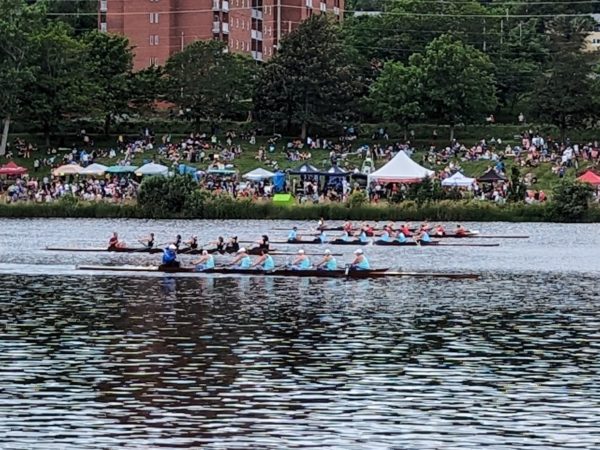
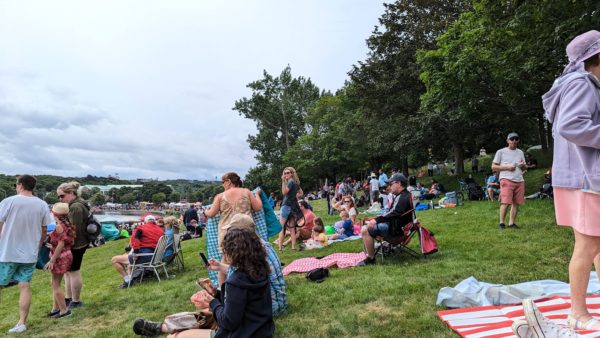

The Royal St John’s Regatta is a day of rowing races on a lake in St John’s called Quidi Vidi Lake (we researched it – there is absolutely no consensus about where that name came from nor about what it means). The racing boats are identical six-seat rowing shells with fixed seats and a coxswain. The races go up the mile-long (1.6 km) lake, turn around and come back down. The races have been held since 1818 (probably earlier than that, but the 1818 races are the accepted “official” first), making it the oldest annual sporting event in North America. The lake on race day is surrounded by vendors, carnival games, music, food tents, kid events, and 15,000 – 20,000 people. Wow! The racing was cool to watch, the people (who had all been anxiously waiting for the past week or so to see if this day would be a holiday or not) were amazing, friendly and happy, the vibe was totally fun, and the India Ultimate Platter we purchased for lunch from the food tent run by the St John’s Hindu Temple was incredible.
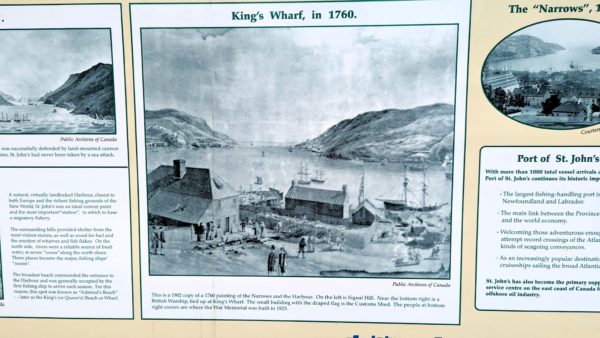
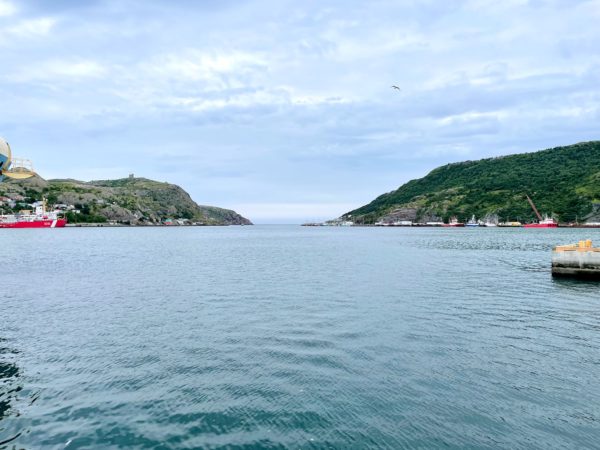
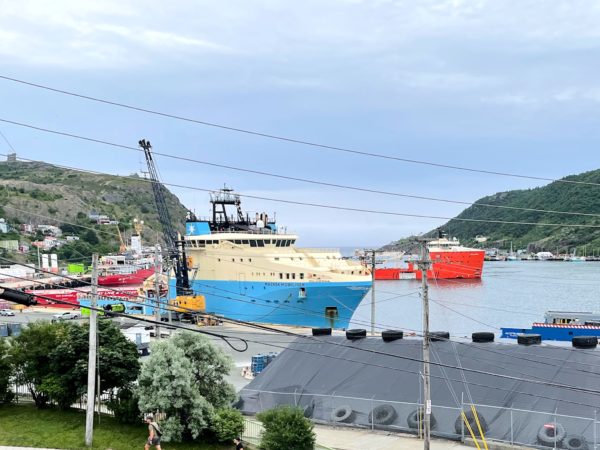
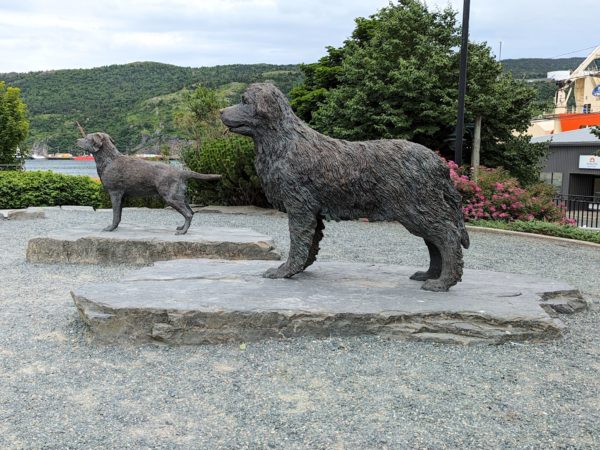
Having seen enough of the races, we walked a few blocks to the center of St John’s. Along the waterfront, we discovered Harbourside Park, the site of frequent gatherings and musical events. Nothing was going on when we were there, but we found signs and commemorative plaques related to the history of St John’s that answered a huge number of questions we had about how the city came to be here and why. Also there were great views of some awesome, huge boats. And two dog sculptures.
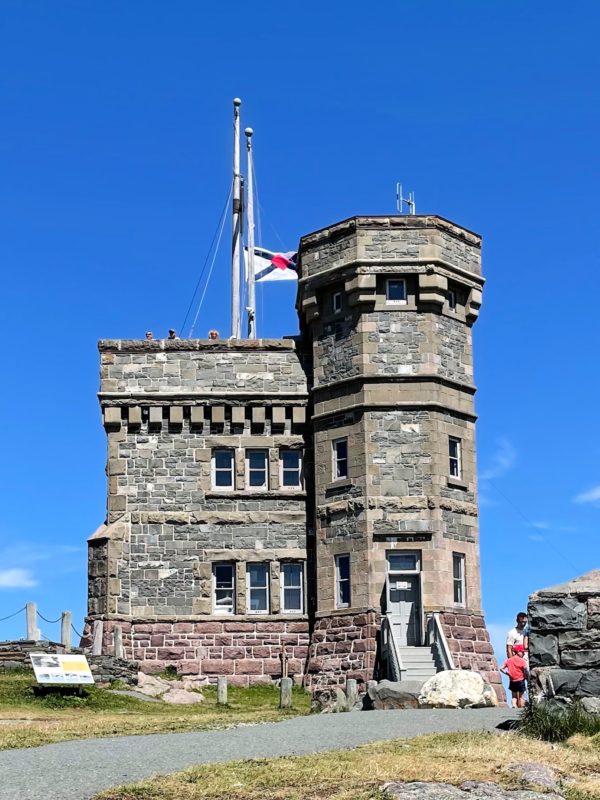
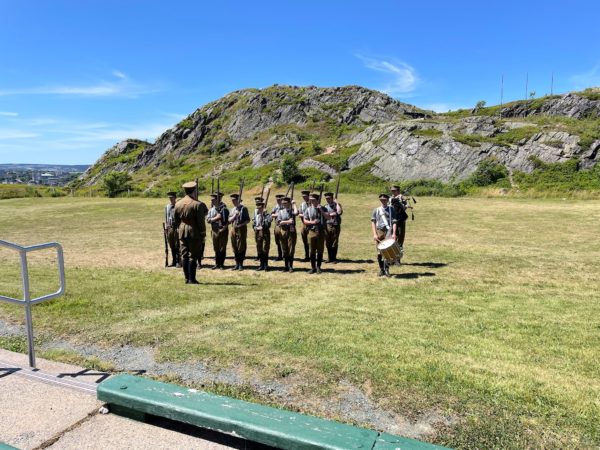

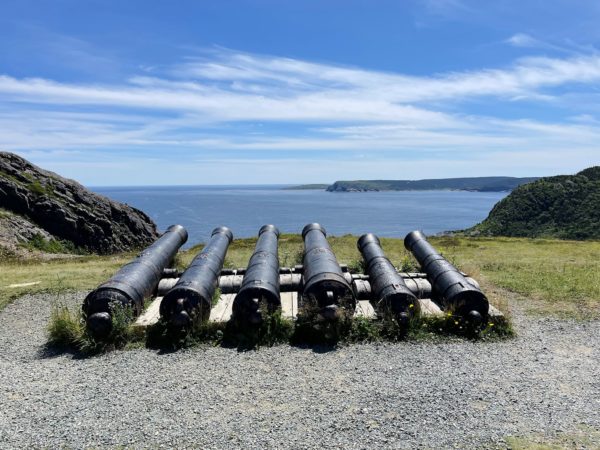
On Repair Day Three, the dealership was open, the parts were due to arrive, and a Mercedes Courtesy Shuttle driver was available to take us anywhere we wanted to go. We had the driver drop us at Signal Hill, a high promontory at the entrance to St John’s Harbour. Signal Hill is a National Historic Site with a fascinating and storied history that we’d gotten a taste of at Harbourside Park the day before. There we learned more about the contentious origins of St John’s, which changed hands on several occasions between the English and the French as the rights to fish and control the resources of the New World were kind of shaking out. Eventually the strategic and commercial importance of the fortifications of Signal Hill became less important as governments stabilized and communication technology evolved, and the site is now a beautiful place to hike, visit the old buildings, and view the harbour and the city of St John’s.
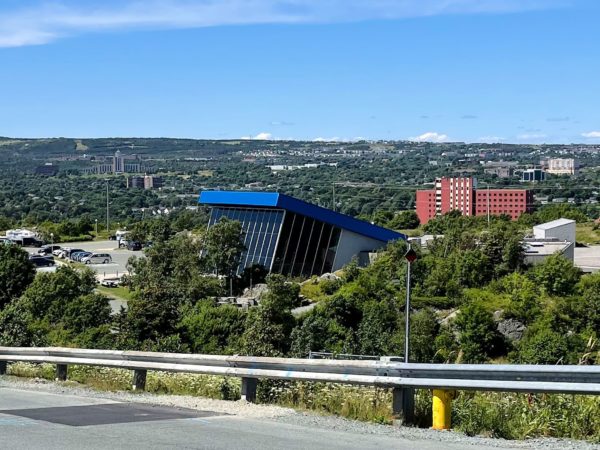
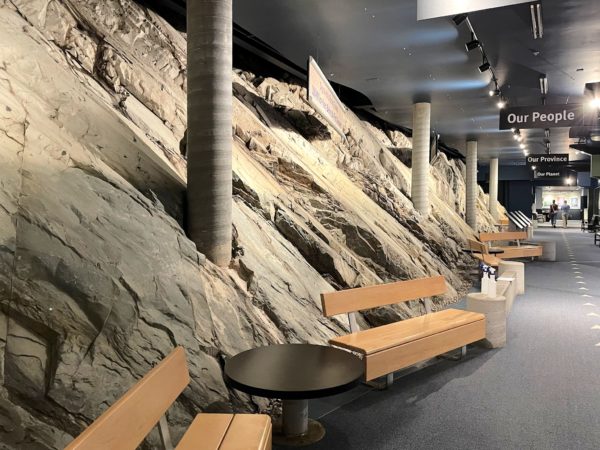
Just across the road from the Signal Hill visitor center is the Johnson Geo Centre. Readers may recall our earlier post about Gros Morne in which we said the visitor center there gave us “the densest historical and scientific presentation we’ve ever tried to digest in a National Park.” That’s still true, but only because the Geo Centre is run by the University, not Parks Canada. Wow! This amazing, underground set of exhibits explains all the geological details of the formation of the continents, the rocks we see, and the timescales over which all of them evolved, where they’re happening now, as well as the important role the formations and evidence found in Newfoundland and Labrador have played in understanding how this planet came to be as we find it. At the end of the exhibition is an exposed wall of the rock of Signal Hill, formed hundreds of millions of years ago and moved to the surface by the processes we’d just learned about. It seems strange to get emotional about a rock, but the experience, especially beginning to understand the magnitude of what has taken place (so far!) and the timeframe over which it is happening, was humbling, inspiring and thought-provoking. Oh, and the truck is ready!
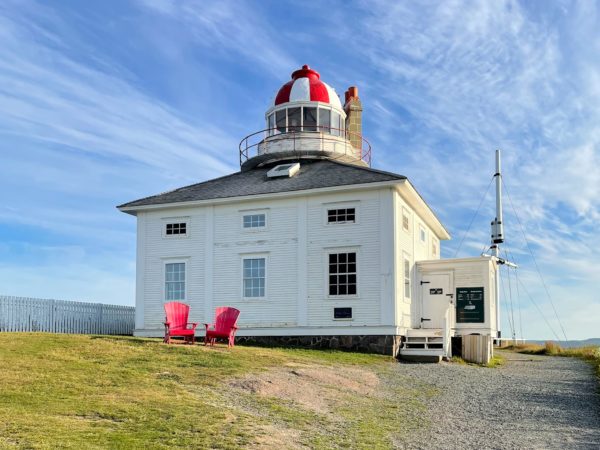
To cap off Repair Day Three, we got a taxi from the Geo Center to Mercedes-Benz St John’s, picked up our again-drivable motorhome, and headed out to Cape Spear. Why? Because it’s the opposite of Anchor Point. Just as Anchor Point, AK is the farthest west you can drive in North America, Cape Spear is the furthest point to the east in North America. We recently were just outside of Cape St Charles in Labrador, at the easternmost point we could drive to on the mainland in Canada. While we’re at it, the westernmost point in Canada is not a point but a line – the Yukon-Alaska border – which we’ve also visited, though I don’t think we made any particular note of that at the time. So noted.
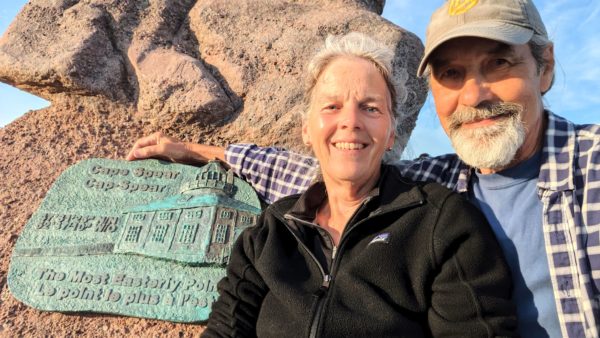
Finally, if you can handle one more extremum visit, before we departed St John’s we had to hit the eastern terminus of the Trans-Canada highway. And so we did (though it was not so glamorous as the other end):
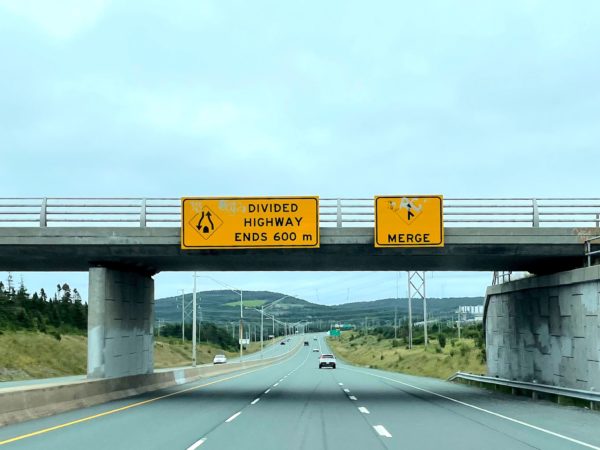
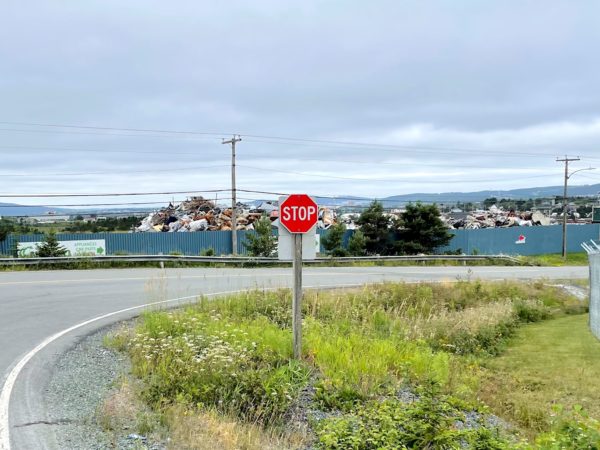
For anyone who’s interested, here are more Pippy Park, Mercedes-Benz, George Street, Regatta, Downtown/Harbourside, Signal Hill, Geo Centre, and Cape Spear pix…
